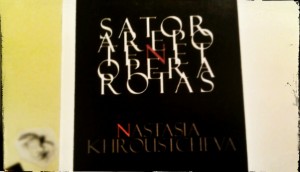By Maria Danova, translator & musicologist, contributor to project AWE “The Secret of the Magic Flute: Western Music & Esotericism”
…in my pieces the musicians usually not only play, but stomp, whisper, exchange violins, tear the scores apart…

Nastasya Khroustcheva, born 1987, is a contemporary composer based in St. Petersburg, Russia, who practices a post-minimalist and often paradoxical approach to composition. Project AWE has recently published a translation of her lecture-performance On Slow and Flawed Music: The Technologies of Future Music which Nastasya delivered in her home city this August. This article serves as a pendant to the lecture.
“Artists are fiery, they do not weep!” These words by Beethoven, although perhaps not completely true to fact, are a perfect expression of the young and furious Nastasya Khroustcheva’s credo. As a woman, she is perfectly authorized to weep, but as a contemporary composer, she laughs with the sarcastic laugh of a sly fox: her internet alter-ego is indeed the famous “stoned fox” made by a British taxidermist Adele Morse that has become no less than a national hero in Russia. Nastasya’s pieces do sound like they are played at some scurrile funeral feast on the occasion of music’s death.

But, as they say: the music is dead, long live the music—forgive the cliché. And it lives on indeed, in multiple forms. In Nastasya’s case, the form is “slow and flawed,” as she persistently repeats in her texts and speeches.
As a literature connoisseur and researcher of interconnections between music and literature, Nastasya borrowed this formula from a novel Moscow to the End of the Line [Moskva-Petushki, 1970] by the Soviet underground writer Venedikt Yerofeyev. The original phrase read: “Everything in the world should happen in a slow and flawed manner, so that the man would not get a chance to puff up, so that the man would be sad and confused.”
That’s exactly what Nastasya wants the listeners to be: confused. As she said in an interview, a musical piece should be like a misguided trolley that brings its passengers to a wrong stop and thus opens their minds to an entirely unknown setting. The listeners are to be irritated, dragged out of their comfort zone.

Many people do not like that, of course, for they love comfort. Others are perfectly happy with it. And some are cautious of her music, considering it to be overly simplified. A famous Moscow-based virtuoso flute player, Ivan Bushuev, member of the Moscow Ensemble of Contemporary Music, called her pieces—well, yes, confusing, and labeled her style “esoteric simplicity.”
This served as an inadvertent compliment especially taking into account that Nastasya herself thinks that the only way out of a musical stalemate is the further development of minimalist ideas. As she puts it, “I have once again discovered the method of repetition, albeit on a new, post-minimalist level: this repetition produces a new layer of meaning, turning the repeated fragment into some kind of Aleph.”

Nastasya loves to use shock, paradox, and irony in her “furious” works and performances, and plays in a postmodern way with pop and rock culture references—it is not by chance that her favorite book is Magister Ludi by Herman Hesse.
To illustrate just a few of such endeavors: Nastasya wrote a Nokia Fugue based on a phone ringtone, collaborated with a punk rock musician causing a sensation giving a joint performance after Shakespeare’s Macbeth purposely misspelled as Magbeth at the St. Petersburg Philharmonic, and the most recent work of this kind is her madrigal Happiness based on the lyrics from a punk rock song by a deceased leader of the Russian underground band The Orgasm of Nostradamus.
Nastasya also lays strong emphasis on the methods of instrumental theater and theatricality. She says: “in my pieces the musicians usually not only play, but stomp, whisper, exchange violins, tear the scores apart, shout quotations from Joyce out loud…” All her public appearances—be it a short concert introduction or a lengthy lecture—are theatrical by nature. Recently she even turned the lecture On Slow and Flawed Music into a one-woman show.
This lecture, available in English on the project AWE’s website, is not only a text designed for theatralized, performative reading, but also a music piece of sorts—this statement is voiced within the very lecture repeatedly, making it sound like a self-referencing machine driving at full steam, a kind of “aleph in motion.” In this structuring of the text according to musical laws, Nastasya, however brave she is, is not pushing any frontiers and continues the tradition that has been in existence for quite a while already. One of the pinnacles of this tradition is of course John Cage’s Lecture on Nothing which he delivered in New York in 1949 and which is still performed and occasionally reinterpreted (Robert Wilson’s 2013 show) across the globe, as an outstanding contemplative piece that lays bare the formal and temporal mechanisms underlying musical and beyond composition.

In her interviews, she often gives unexpected answers that leave you guessing if she really meant it. But with Nastasya you never really know for sure—so far, she remains a mystery, and there is certainly some esoteric component to her oeuvre. So, as of now, “esoteric simplicity” seems to be a just definition of her work—simplicity with a grain of fury and a handful of post-postmodern paradoxes.
Do all these paradoxes stem from the Shakespearean source, the bitter and sarcastic phrase from Macbeth that life “is a tale told by an idiot, full of sound and fury, signifying nothing”? Maybe. At least one thing is clear: for Nastasya, it’s all about fury.
Talking about her piece with a Shakespeare-inspired title Much Ado About Fury, she once stated plainly that, out of the three parts that Plato divided human soul into—the reasonable, the wanting, and the furious, spirited, hot-blooded one,—she is definitely in favor of the latter.
Nastasya Khroustcheva performing Dances of a Gray Fox













